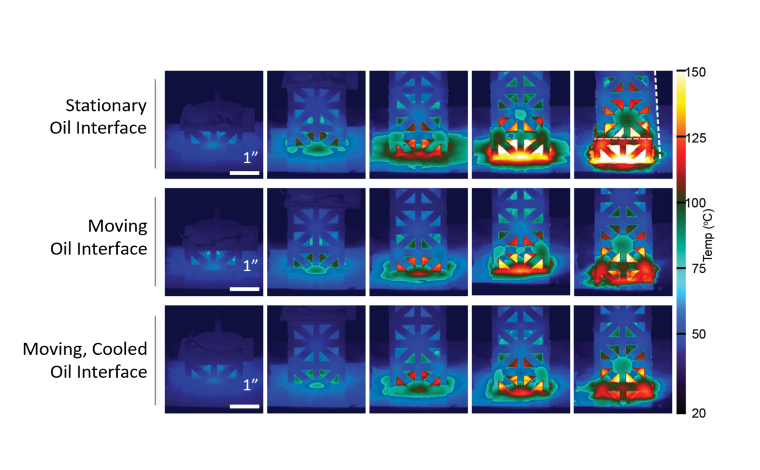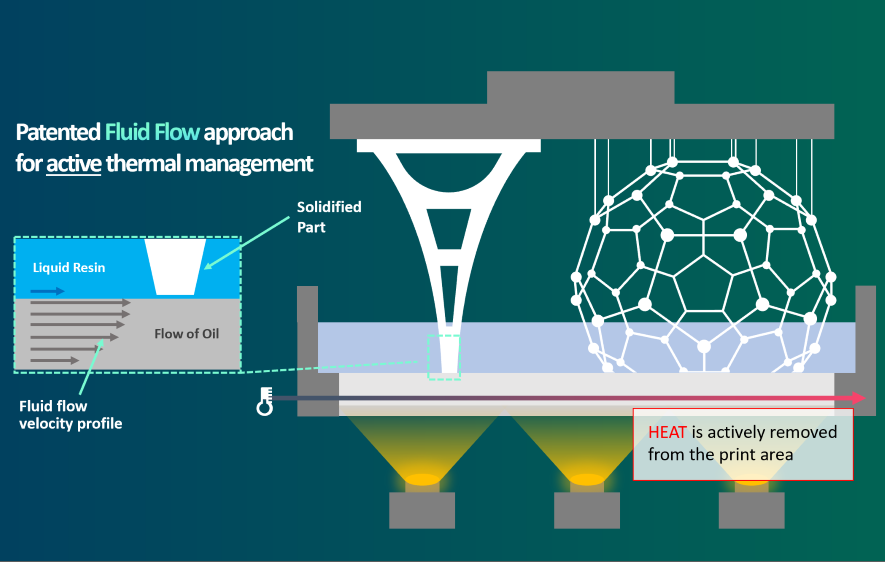
In the manufacturing industry, the laws of physics are the great playing field leveler. Unconcerned with money, marketing, or good intentions, first principles innovation can create big leaps in performance and competitive advantage.
Within the last 10 years, the 3D printing industry experienced one of these leaps with the proliferation of area-wide printing methods. Many companies found that fusing or curing an entire layer at once gave them a first principles advantage in speed and an improvement in consistency across a layer. This evolution cracked open the door for more mass production of end-use parts.
But mass production isn’t just a speed race. Together with larger production runs comes the requirement of even tighter process control. For plastics, that means controlling thermal variation. The answer again lies in first principles innovation.
Heat management can make or break 3D printing as a viable next step in high throughput manufacturing. Imagine injection molding but without the benefit of cooling lines. Manufacturers would attempt to run at the cycle times they’re accustomed to, but the increasing mold temperature would change the properties of the material, and their outputs would be subject to all manner of defects and variation in dimensions and properties. The inevitable result would be a slowdown, running the process at a fraction of the speed it is capable of.
That’s the situation many 3D printing companies find themselves in today. When raster speeds became irrelevant and lasers were displaced by almost limitless framerates, the new barrier became the management of heat buildup. Like the injection molding scenario, slowing down became necessary to maintain control of the process. The effects become even more pronounced with larger build areas, further limiting that avenue for productivity increases. As progress stalled, the industry has seen an (long overdue) increased focus on software, automation, and applications as companies try to carve out a competitive advantage.
The best ideas are often borrowed, and the decades of improvement in traditional manufacturing tell us that moving faster requires active heat management. While it is not the only engineering challenge to solve in the realm of additive manufacturing, it can confidently be listed as a necessary capability to push size, speed, and consistency to the next level of productivity for plastics production.
It was this reality that led to the commercialization of the High Area Rapid Printing (HARP) technology from Azul 3D. To stand out in a crowded industry, full of confusing claims and diminishing differentiation, it was necessary to create a brand-new market space, starting from the very basics.
Temperature control in production is most vital right where the printing and the networking of polymers occurs – in our case, where the UV energy reaches the resin. This is also where the heat from the reaction is released. This means that inevitably 1) the printing surface and the cooling surface are the same and 2) the cooling substrate must be clear to allow the energy to pass unimpeded.
Further, to actively pull heat from the system and not be limited by thermal conductivity and passive dissipation, that substrate must also be fully mobile – such as a fluid.

Image courtesy of Walker, D.A., et. al., Science 366, 360-364 (Walker, D.A., et. al., Science 366, 360-364 (2019).
HARP is a revolutionary new process where the liquid resin floats directly on top of, but does not interact with, an optically transparent, chemically inert, and constantly flowing layer of cooling oil that absorbs heat from the reaction and carries it out of the system. The result is a stable build temperature no matter how large, high, or fast you go. An elegant answer to a fundamental problem.
HARP is not a do-it-all solution. It’s a platform for printing products very fast for those with the flexibility to design for the process. But for the known and yet-undiscovered applications that are limited today by productivity, economics, and variability, it represents an opportunity to go bigger and faster than ever before and drive the next wave of industry growth.
Azul 3D is participating at Additive Manufacturing Strategies, taking place in New York City from February 7-9, 2023. Azul 3D Chief Revenue Officer Tuan TranPham will moderate “Panel 2: The Future of Composites and Polymers in AM” on February 7. Register for your ticket to attend here.
Subscribe to Our Email Newsletter
Stay up-to-date on all the latest news from the 3D printing industry and receive information and offers from third party vendors.
You May Also Like
Precision at the Microscale: UK Researchers Advance Medical Devices with BMF’s 3D Printing Tech
University of Nottingham researchers are using Boston Micro Fabrication‘s (BMF) 3D printing technology to develop medical devices that improve compatibility with human tissue. Funded by a UK grant, this project...
3D Printing Webinar and Event Roundup: April 21, 2024
It’s another busy week of webinars and events, starting with Hannover Messe in Germany and continuing with Metalcasting Congress, Chinaplas, TechBlick’s Innovation Festival, and more. Stratasys continues its advanced training...
3D Printing Webinar and Event Roundup: March 17, 2024
It’s another busy week of webinars and events, including SALMED 2024 and AM Forum in Berlin. Stratasys continues its in-person training and is offering two webinars, ASTM is holding a...
3D Printed Micro Antenna is 15% Smaller and 6X Lighter
Horizon Microtechnologies has achieved success in creating a high-frequency D-Band horn antenna through micro 3D printing. However, this achievement did not rely solely on 3D printing; it involved a combination...






























